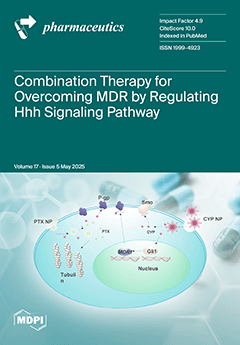Background/Objectives: This study reports the green synthesis, optimization, characterization, and multifunctional evaluation of silver nanoparticles (AgNPs) using an ethanolic
Aronia melanocarpa berry extract. The objective was to establish optimal synthesis conditions; assess the in vitro stability; and evaluate the antioxidant, photocatalytic, and photoprotective
[...] Read more.
Background/Objectives: This study reports the green synthesis, optimization, characterization, and multifunctional evaluation of silver nanoparticles (AgNPs) using an ethanolic
Aronia melanocarpa berry extract. The objective was to establish optimal synthesis conditions; assess the in vitro stability; and evaluate the antioxidant, photocatalytic, and photoprotective activities.
Methods: The cytogenotoxic effects of the AgNPs were evaluated on
Triticum aestivum roots. The AgNPs were synthesized via bioreduction using an ethanolic extract of
A. melanocarpa under varied pH, AgNO
3 concentration, extract/AgNO
3 ratio, temperature, and stirring time, with optimization guided by UV–Vis spectral analysis. The AgNPs were further characterized by FTIR, DLS, TEM, and EDX. In vitro stability was evaluated over six months in different dispersion media (ultrapure water; 5% NaCl; and PBS at pH 6, 7, and 8). Biological assessments included antioxidant assays (lipoxygenase inhibition, DPPH radical scavenging, metal chelation, and hydroxyl radical scavenging), photocatalytic dye degradation, and SPF determination.
Results: Optimal synthesis was achieved at pH 8, 3 mM AgNO
3, extract/AgNO
3 ratio of 1:9, 40 °C, and 240 min stirring. The AgNPs were spherical (TEM), well dispersed (PDI = 0.32), and highly stable (zeta potential = −40.71 mV). PBS pH 6 and 7 ensured the best long-term colloidal stability. The AgNPs displayed strong dose-dependent antioxidant activity, with superior lipoxygenase inhibition (EC
50 = 18.29 µg/mL) and the effective photocatalytic degradation of dyes under sunlight. Photoprotective properties were confirmed through UV absorption analysis. The AgNPs showed a strong antimitotic effect on wheat root cells.
Conclusions: The study demonstrates that
A. melanocarpa-mediated AgNPs are stable, biologically active, and suitable for potential biomedical, cosmetic, and environmental applications, reinforcing the relevance of plant-based nanotechnology.
Full article






